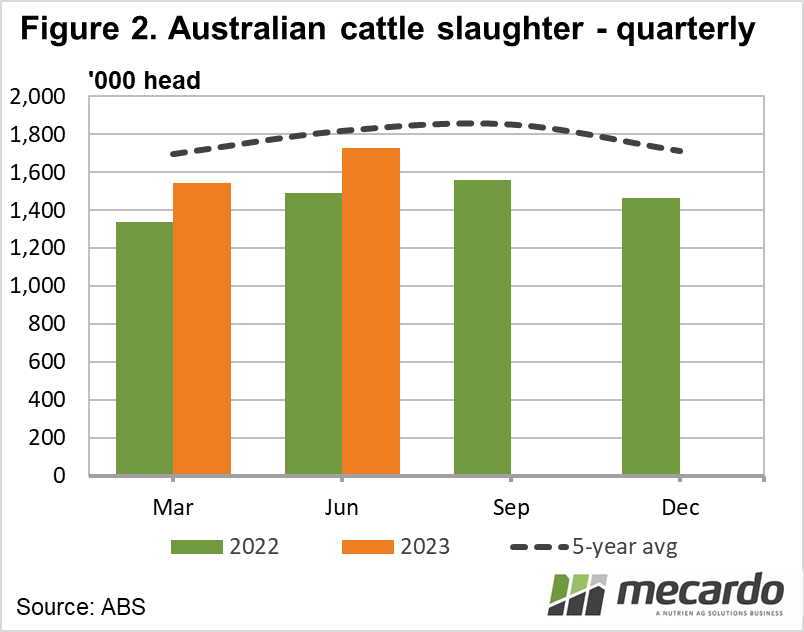The latest slaughter and production data from the Australian Bureau of Statistics (ABS) is in, and unsurprisingly it marks a potential move into the next phase of the cattle cycle. As herd growth has matured across the country and falling young cattle prices add further disincentive for further restocking, the Female Slaughter Rate (FSR) has moved above the 47% rebuild marker; albeit only just.
Total cattle slaughter for the April-June period was 1.72 million head, up 16% from the same quarter the previous year, and just shy of 2 million head higher than the January-March period of 2023. It was the highest quarterly slaughter since September 2020 but still sat 5% lower than the five-year average. Year-to-June total slaughter now sits at about 7% below the five-year average, and 13% lower than for the same six months last year.
At 48% the FSR has only just risen above the traditional industry market for liquidation rather than rebuild, but more telling is the increase since the previous quarter. The FSR has seen a significant jump from the 42% FSR that was recorded in the March 2023 quarter. The FSR was last at the 48% mark in the June quarter of 2021 and has sat at 44% or lower ever since. The five-year average for the FSR for the June quarter is 52%, and historically it is the highest for the year, dropping lower for the remaining two quarters. All other industry indicators are showing us that this is unlikely to be the case, especially if a dry spring eventuates.
If we look at actual female slaughter numbers, we have to go back a bit further to the September quarter of 2020 to find it higher, which as mentioned above was when total slaughter was last above current rates as well. Female slaughter has lifted 26% year-on-year but still sits 13% below the five-year average. It has climbed more than 20% since the first three months of the year.
Finally state specific FSRs see NSW at 49% for the quarter, which is equal to the five-year average and its highest point since September 2020, following the total slaughter figures. It has risen 7% from the previous quarter when NSW was in line with the national FSR of 42%. Queensland, while still 5% shy of the five-year average at 40%, has actually risen 8% from the previous quarter, and 5% year-on-year. Victoria always has the highest FSR due to their dairy herd, but only rose 1% from last quarter to 63%.
What does it mean?
The FSR is averaging 45% for the year-to-date, which is still below liquidation. Last year the average FSR was 43%, and in 2021 (for the entire year) it was also 45%. However, the FSR was on the decrease for the second half of 2021, which won’t be the case here.
If we look back to the last post-record price and good season high, the national FSR hit 47% at the start of 2018 and then remained at 50% or higher (aka liquidation) right through until the final quarter of 2020. The changing season saw it jump nearly 10% in just one quarter, and I would expect if the rain doesn’t come in the spring the same will happen again this year.
Have any questions or comments?
Key Points
- ABS quarterly total cattle slaughter has climbed to its highest level since the September 2020 quarter, up 16% year-on-year.
- The Female Slaughter Rate has followed suit, reaching 48%, indicating a potential future move to the liquidation phase of the cycle.
- NSW FSR has reached five-year-average levels, while Queensland remains 5% below the average figure.
Click on figure to expand
Click on figure to expand
Data sources: MLA, ABS, Mecardo














